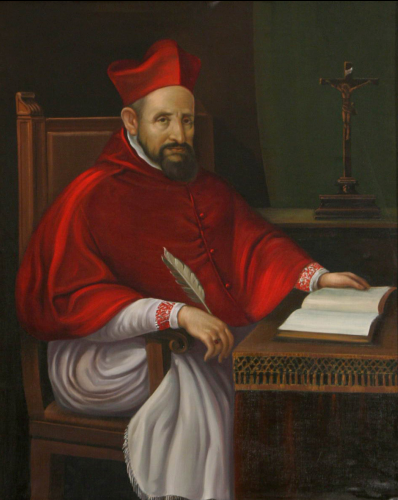
St. Robert Bellarmine, SJ (+1621)
This blog, Ars bene moriendi, is named for the great work of the Jesuit, Cardinal, and Doctor of the Church, St. Robert Bellarmine. This 17th century Saint of the Church was a great champion of the "counter Reformation" and, traditionally, his feast day was observed on 13 May. In the revised calendar of 1970, the feast of St. Robert Bellarmine was transferred to 17 September, which is the anniversary of his death in 1621AD.
St. Robert was a great scholar and a great saint. The Old Catholic Encyclopedia notes of his life: "A distinguished Jesuit theologian, writer, and cardinal, born at Montepulciano, 4 October, 1542; died 17 September, 1621. His father was Vincenzo Bellarmino, his mother Cinthia Cervini, sister of Cardinal Marcello Cervini, afterwards Pope Marcellus II. He was brought up at the newly founded Jesuit college in his native town, and entered the Society of Jesus on 20 September, 1560, being admitted to his first vows on the following day. The next three years he spent in studying philosophy at the Roman College, after which he taught the humanities first at Florence, then at Mondovì. In 1567 he began his theology at Padua, but in 1569 was sent to finish it at Louvain, where he could obtain a fuller acquaintance with the prevailing heresies. Having been ordained there, he quickly obtained a reputation both as a professor and a preacher, in the latter capacity drawing to his pulpit both Catholics and Protestants, even from distant parts. In 1576 he was recalled to Italy, and entrusted with the chair of Controversies recently founded at the Roman College. He proved himself equal to the arduous task, and the lectures thus delivered grew into the work "De Controversiis" which, amidst so much else of excellence, forms the chief title to his greatness. This monumental work was the earliest attempt to systematize the various controversies of the time, and made an immense impression throughout Europe, the blow it dealt to Protestantism being so acutely felt in Germany and England that special chairs were founded in order to provide replies to it. Nor has it even yet been superseded as the classical book on its subject-matter, though, as was to be expected, the progress of criticism has impaired the value of some of its historical arguments.
In 1588 Bellarmine was made Spiritual Father to the Roman College, but in 1590 he went with Cardinal Gaetano as theologian to the embassy Sixtus V was then sending into France to protect the interests of the Church amidst the troubles of the civil wars....Gaetano's mission now terminating, Bellarmine resumed his work as Spiritual Father, and had the consolation of guiding the last years of St. Aloysius Gonzaga, who died in the Roman College in 1591. Many years later he had the further consolation of successfully promoting the beatification of the saintly youth. Likewise at this time he sat on the final commission for the revision of the Vulgate text. This revision had been desired by the Council of Trent, and subsequent popes had laboured over the task and had almost brought it to completion....In 1592 Bellarmine was made Rector of the Roman College, and in 1595 Provincial of Naples. In 1597 Clement VIII recalled him to Rome and made him his own theologian and likewise Examiner of Bishops and Consultor of the Holy Office. Further, in 1599 he made him Cardinal-Priest of the title of Santa Maria in viâ, alleging as his reason for this promotion that 'the Church of God had not his equal in learning'."
The Old Catholic Encyclopedia concludes by describing him thus: "His spirit of prayer, his singular delicacy of conscience and freedom from sin, his spirit of humility and poverty, together with the disinterestedness which he displayed as much under the cardinal's robes as under the Jesuit's gown, his lavish charity to the poor, and his devotedness to work, had combined to impress those who knew him intimately with the feeling that he was of the number of the saints."
He lived, then, in the era of the Reforms of Trent, the French Wars of Religion, the reign of James I of England, and the Galileo Case, each of which was a matter that St. Robert, as a prince of the Church, had occasion to deal with. He would die in 1621, and is buried in the Jesuit Church of Sant'Ignazio in Rome.

The Apse of the Roman Church of Sant'Ignazio, where St. Robert is buried.
["Lazio Roma SIgnazio tango7174" by Tango7174 - Own work. Licensed under GFDL via Commons]
Here is the website of the Church where he is buried in Rome: Chiesa di Sant'Ignazio
St. Robert was canonized in 1930 by Pope Pius XI and named a Doctor of the Church. His feast until the reforms of Paul VI fell on 13 May -- it was moved to 17 September to correspond to the day of his death in that reform.
For a more detailed life of St. Robert, you might note these links:
Old Catholic Encyclopedia: St. Robert Bellarmine
Catholic Saints Info: St. Robert Bellarmine
For the text of his great work, Ars bene moriendi, on living and dying well, you should visit here:
St. Robert Bellarmine, Ars bene moriendi
In closing, it is interesting to note that, prior to his election, Pope Francis held the title of Cardinal-Priest of San Roberto Bellarmino.
Live well!